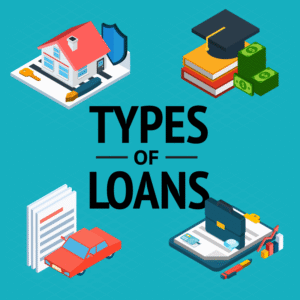Loans are financial tools that help individuals and businesses access capital for various needs. Whether it’s purchasing a home, paying for education, starting a business, or managing emergencies, loans play a crucial role in financial planning. However, not all loans are the same. They vary in purpose, structure, repayment terms, interest rates, and eligibility criteria. In this article, we’ll explore five common types of loans: personal loans, home loans, auto loans, student loans, and business loans.
1. Personal Loans
Definition:
A personal loan is an unsecured loan offered by banks, credit unions, and online lenders. It can be used for a variety of personal expenses, including medical bills, vacations, debt consolidation, or home repairs.
Key Features:
- Unsecured: No collateral required.
- Fixed interest rates: Most personal loans have fixed interest rates and predictable monthly payments.
- Loan term: Typically ranges from 1 to 7 years.
Pros:
- Flexibility in use.
- Fast approval and funding (often within a few days).
- Fixed repayment schedule.
Cons:
- Higher interest rates compared to secured loans.
- Approval depends heavily on credit score.
- Penalties for late payments.
Example:
Jane needs $10,000 for home renovation. She applies for a personal loan and receives funds with a 10% interest rate, repayable over 5 years.
2. Home Loans (Mortgage Loans)
Definition:
Home loans, or mortgage loans, are used to purchase real estate. These loans are typically long-term and secured by the property being purchased.
Key Features:
- Secured loan: The home acts as collateral.
- Long repayment terms: Often 15 to 30 years.
- Interest types: Fixed-rate or adjustable-rate mortgages (ARMs).
Pros:
- Enables homeownership with manageable monthly payments.
- Interest may be tax-deductible.
- Often comes with lower interest rates due to collateral.
Cons:
- Long-term financial commitment.
- Risk of foreclosure if payments aren’t made.
- Upfront costs such as down payment and closing fees.
Example:
A couple buys a house for $300,000, makes a $60,000 down payment, and finances the rest with a 30-year fixed-rate mortgage at 5% interest.
3. Auto Loans
Definition:
An auto loan is a secured loan used to purchase a new or used vehicle. The car itself serves as collateral.
Key Features:
- Secured loan: Lender can repossess the car if the borrower defaults.
- Term length: Typically 3 to 7 years.
- Interest rates: Depend on credit score, vehicle type, and loan term.
Pros:
- Easier to qualify for due to the loan being secured.
- Competitive rates from dealerships and banks.
- Helps spread out the cost of vehicle purchase.
Cons:
- Risk of repossession.
- Car value depreciates quickly.
- Extra fees for long-term loans or poor credit.
Example:
Mark purchases a $20,000 car with a $5,000 down payment. He finances the remaining $15,000 with a 5-year loan at 6% interest.
4. Student Loans
Definition:
Student loans are designed to help students pay for higher education expenses, including tuition, books, and living costs.
Types:
- Federal student loans: Offered by the government, with fixed interest and flexible repayment options.
- Private student loans: Provided by private lenders, often with variable rates and stricter terms.
Pros:
- Enables access to higher education.
- Grace periods typically allow time after graduation before repayment begins.
- Federal loans offer options like income-driven repayment and forgiveness programs.
Cons:
- Accumulated debt can be burdensome post-graduation.
- Private loans have fewer protections and less flexibility.
- Long repayment periods (10–25 years).
Example:
Emily takes out a $40,000 federal student loan to complete her degree. After graduation, she enters a repayment plan based on her income.
5. Business Loans
Definition:
Business loans provide funding for new or existing businesses. They can be used for startup costs, expansion, equipment purchase, or working capital.
Types:
- Term loans: Lump sum repaid over time with interest.
- SBA loans: Backed by the U.S. Small Business Administration.
- Lines of credit: Revolving credit that businesses can draw from as needed.
Pros:
- Fuels business growth and stability.
- Structured repayment helps with budgeting.
- SBA loans have favorable terms and lower down payments.
Cons:
- Often require a detailed business plan and good credit.
- Collateral or personal guarantees may be required.
- Application process can be lengthy.
Example:
A small bakery takes a $50,000 SBA loan to open a second location. The loan has a 10-year term at 4% interest.
Conclusion
Understanding the different types of loans is crucial for making informed financial decisions. Each loan type serves a specific purpose and comes with its own advantages and risks. Here’s a quick summary:
| Loan Type | Purpose | Secured? | Interest Rates | Typical Term |
|---|---|---|---|---|
| Personal Loan | Flexible personal use | No | Moderate to high | 1–7 years |
| Home Loan | Buy a home | Yes | Low to moderate | 15–30 years |
| Auto Loan | Buy a vehicle | Yes | Moderate | 3–7 years |
| Student Loan | Education expenses | Usually no | Low (federal), varies | 10–25 years |
| Business Loan | Start/expand a business | Often yes | Varies widely | 1–25 years |
Choosing the right loan requires evaluating your financial needs, creditworthiness, and repayment capability. Always compare offers, read the fine print, and understand the total cost—including interest and fees—before signing any loan agreement. Whether you’re investing in your future or covering an immediate need, the right loan can be a powerful financial tool when used responsibly.

Leave a Reply